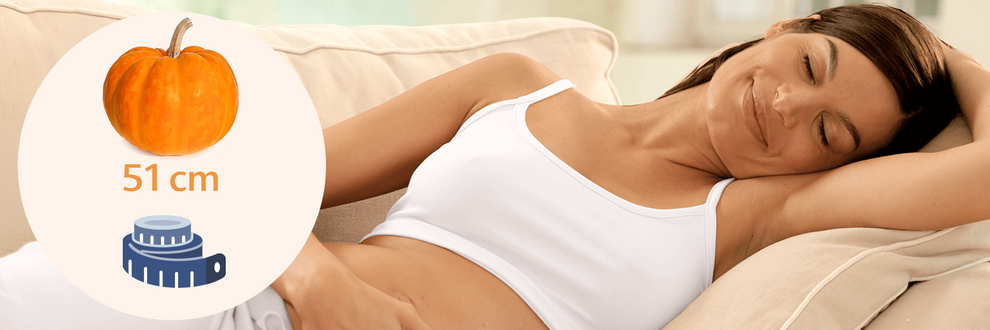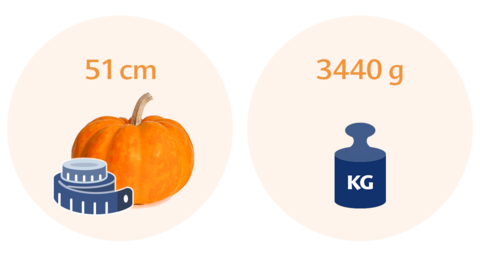Pregnancy weeks:
Week 40 of pregnancy: Your baby has reached their birth weight – but they might still want to grow a bit more

At the end of week 40, you’ve finally reached your due date, as calculated by your doctor on the basis of your last period and the ultrasound measurements. Your baby may already have been born by now, or maybe they’re making you wait for another few days. Most babies are ready to be born 38 weeks after conception and are equipped with everything they need to survive on their own outside the womb. Your pregnancy will have given you all the feelings and instincts you need as a mum to look after a newborn baby and to nurture them as they grow through childhood into adulthood.
Size of your baby in week 40

Your baby is around 51 cm long, so they’ve reached their birth size. If you still have to imagine holding them in your arms, thinking of them as a very large ornamental pumpkin is more or less exactly right. They weigh around 3440 grams, about average for all newborns.
Your baby’s development
Over the last few weeks, your baby has put on so many reserves of fat that they now make up around 15 per cent of their body weight. In week 40, their liver also absorbs more starch from your bloodstream, which their body will convert into glucose, a form of sugar, once they’re born. The glucose is then released into their blood. This is crucial as it’s their first source of energy for three or four days after the birth until you produce mature breast milk and start breastfeeding.
The first milk you produce, known as colostrum, gives your baby important antibodies to build up their developing immune system. This gives them protection from the germs they’ll come into contact with once they’re outside the womb, and will help ward off colds in particular, which they’ll quickly be exposed to.
Right before they’re born, your baby won’t have enough space in your womb. They’ll curl up in the foetal position, with their head down in your lesser pelvis, and wait. You’ll notice that they stay in this hunched position for the first two or three weeks after they’re born.
What your baby will go through
Birth is an exciting and demanding process for your baby too. It began with the practice contractions of the last few weeks, which made things very uncomfortable for them: this initial labour makes your womb contract fully, first at longer and then at shorter intervals, and the muscles really squeeze their body and push it downwards.
Before their head, the largest part of their body, can pass through your vagina, your baby has to turn 90 degrees – this is usually one of the most painful parts of giving birth for you.
Once your baby has done that, their head will be visible at the entrance to your vagina and the air that now hits their fontanelle from the outside world will stimulate their first breath. This is usually accompanied by their first scream and a look of terror on their face, but it means they’ve survived the critical part of the birth. Their shoulders still need to come out (you’ll have to push as hard as you can a few times), but once they’re out, the rest of your baby will slide out nice and easily. Now what your baby needs most of all is you!
What it’s like for the mum-to-be in week 40
The months of longing and waiting are almost at an end, as you’ve reached your due date and your pregnancy is nearly over.
The end of your pregnancy also means the end of your steady weight gain: after you have your baby, you’ll shed your excess weight quickly as a result of the hard work of giving birth and beginning to breastfeed. This is natural and normal – because you need plenty of energy as a new mum!
Babies’ movements in the womb vary considerably at this stage. The parts of their body which aren’t as restricted could be very active, or your baby will be resting and waiting for your uterus to start contracting and birth to begin.
Pregnant women can also experience a wide range of different contractions. Some days you may feel that it’s finally starting now, only to then stop getting contractions and for things to calm down again. Think of it as the calm before the storm.
Common signs and symptoms
A new challenge for your body
Symptoms can vary enormously in terms of severity and location in the last week of pregnancy, as your body is facing a new challenge and a lot of hard work. The cocktail of hormones causes your body to try to cleanse itself again, which may result in feeling nauseous and possible vomiting and/or diarrhoea. The intestinal contractions involved in diarrhoea stimulate uterus contractions, and irregular uterus contractions can also trigger diarrhoea – the two mechanisms support each other. Headaches, stomach aches and wind can also be signs that you’re about to give birth.
Stomach aches
When labour begins, the contractions will cause stomach aches and an intense pulling sensation in your abdomen. These will initially occur at irregular intervals over a number of hours before they eventually become even more intense and occur more regularly. At this stage your cervix dilates, which can cause bleeding. Once your contractions are regularly occurring roughly every five minutes at medium-strong to strong intensity, tell your midwife or get your partner to take you to the hospital.
Questions you may want to ask your doctor
Epidural anaesthesia (EA) to numb the pain of giving birth
Women expecting their first baby have no real way of knowing how their body will react to the pain of giving birth, and how they themselves will cope with it.
If birth is taking a long time, seems to be stalling or you’re already exhausted and worn out, you may be offered EA to numb the pain of labour.
EA involves injecting a painkiller into the area between the vertebrae in your spine, in the roots of the nerve fibres in the spinal canal, where it has the effect of reducing the amount you feel in your pelvic region. You can still do the hard work of pushing in order to give birth, but you won’t feel pain while doing so.
As with all medical interventions, EA has restrictions, risks and side effects. So you’ll need to weigh up the pros and cons – speak to your doctor about the option of pain relief, and make sure you know everything you need to know about it before you make your decision.



